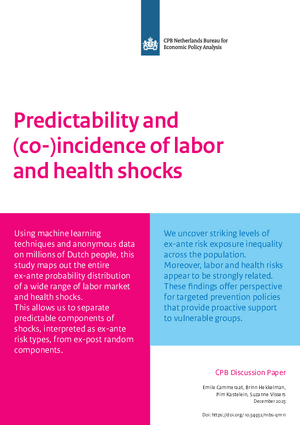Predictability and (co-)incidence of labor and health shocks

Using machine learning techniques and anonymous data on millions of Dutch people, this study maps out the entire probability distribution of a wide range of labor market and health shocks. The degree of inequality in risk exposure across the population is striking. Most people have a low probability of becoming seriously ill or dependent on social benefits, while one percent of people bears up to thirty times more risk compared to the population average. People with a flexible employment contract, low income, little wealth and migration background are overrepresented within this high-risk group.
Downloads
Moreover, labor market and health risks appear to be strongly related. The percent of people with the highest health risk are also four times more likely to become dependent on social benefits. Past setbacks are also a precursor to future setbacks. For example, people who experience debt problems have a doubled chance of consuming psychiatric medication in the following year. These findings offer perspective for targeted prevention policies that provide proactive support to vulnerable groups.
Authors




